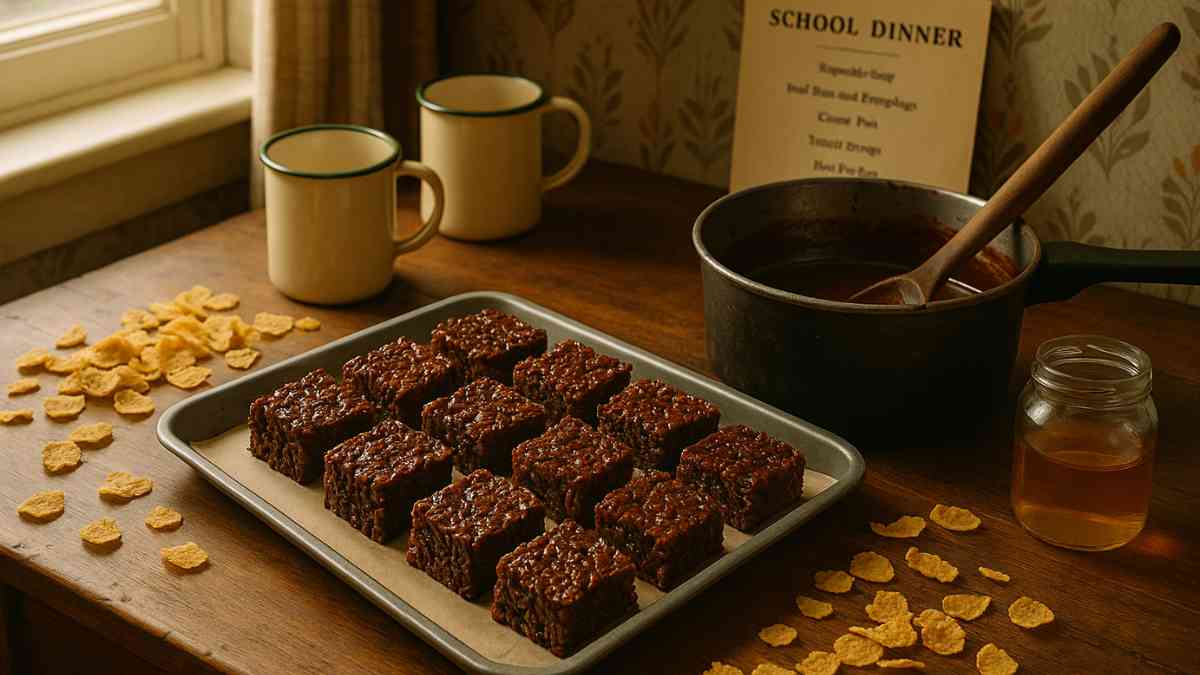Chocolate Cracknell: A Nostalgic British Delight That Still Charms Generations

Chocolate cracknell is one of those treasured British classics that transports you straight back to your school days. If you grew up in the UK in the late 20th century, chances are high that you remember the joy of finding a chunk of this golden syrup-laced, chocolatey treat on your dinner tray. It’s a nostalgic pudding with humble ingredients, a simple method, and a surprisingly rich cultural footprint. Over the years, chocolate cracknell has evolved from a school canteen staple to a beloved retro dessert that home bakers across Britain are bringing back to life.
What Is Chocolate Cracknell?
Chocolate cracknell is a no-bake dessert made by combining golden syrup, cocoa powder, butter, and cornflakes or crushed cereal into a sticky mixture that sets firm when chilled. Unlike many modern desserts, cracknell doesn’t require fancy techniques or exotic ingredients. Its beauty lies in its simplicity and the deeply satisfying crunch combined with a rich, buttery cocoa flavour.
Though some may confuse it with chocolate cornflake cakes or rice crispy buns, cracknell is unique for its chewy texture and syrupy, fudge-like coating. It’s denser, darker, and more indulgent than its lighter, puffed cousins. The traditional method involves mixing all the ingredients in a pan, pouring the mixture into a tray, letting it cool, and slicing it into squares.
A Brief History of Chocolate Cracknell
The origins of chocolate cracknell are rooted in post-war Britain when school meals were designed to be filling, nutritious, and budget-friendly. The introduction of compulsory school meals in the 1940s and 50s led to a wave of creative, cost-effective puddings, and chocolate cracknell rose to fame alongside cornflake tart and jam roly-poly.
By the 1970s and 80s, chocolate cracknell had become a firm favourite in school kitchens across England, Wales, and Scotland. Many adults today remember it fondly as the highlight of their school dinners, a dessert that made long afternoons more bearable. It was usually served chilled in blocks, with a thick, satisfying crunch and a caramel-chocolate depth that made it stand out from other cafeteria offerings.
Over time, as school catering became more standardised and health-conscious, many of these old puddings were phased out. But the affection for cracknell never died. Instead, it lived on in memory and in the occasional nostalgic food blog or community recipe collection, until its more recent revival among home bakers and food enthusiasts.
Ingredients That Make Chocolate Cracknell Special
One of the key attractions of chocolate cracknell is that it requires only a handful of basic ingredients. Yet the chemistry of those ingredients, when combined just right, results in something more than the sum of its parts.
- Golden Syrup – The hero of the recipe. It provides the chewy texture and deep caramel flavour. Golden syrup also acts as the binding agent that holds everything together.
- Butter – Adds richness and helps soften the structure slightly. It’s also essential in achieving the glossy finish.
- Cocoa Powder – A good-quality cocoa powder gives the cracknell its distinct, bold chocolate flavour. This is what separates it from the overly sweet taste of many commercial chocolate treats.
- Cornflakes – While some modern versions use rice crispies or bran flakes, the traditional choice is cornflakes, crushed slightly. They offer just the right level of crunch and absorption for the syrupy coating.
- Optional Additions – Some people enhance their cracknell with a pinch of salt, a few drops of vanilla extract, or even dried milk powder for a more school-authentic experience.
Step-by-Step Method for Perfect Cracknell
While there are multiple versions and tweaks, the basic steps to prepare chocolate cracknell remain fairly consistent.
- Melt the Base
In a large saucepan, melt butter and golden syrup together over gentle heat. Stir continuously until they form a smooth, bubbling mixture. - Add Cocoa Powder
Take the pan off the heat and stir in the cocoa powder, making sure there are no lumps. The mixture should turn dark and glossy. - Fold in the Cornflakes
Add the cornflakes gradually, folding them into the syrup mixture. Ensure all the flakes are coated evenly but not crushed into powder. - Transfer to a Tray
Line a square baking tin or tray with parchment paper. Press the mixture firmly into the tray, using the back of a spoon or clean hands. - Chill and Set
Place the tray in the fridge for at least two hours. Once firm, slice into squares or bars. Store in an airtight container in the fridge.
Variations on the Classic Recipe
While purists argue for sticking with the traditional cornflake version, others have experimented with great success.
- Oaty Cracknell: Replace some or all of the cornflakes with rolled oats for a flapjack-meets-cracknell hybrid.
- Nutty Delight: Add chopped hazelnuts, almonds, or peanuts for added crunch and protein.
- Festive Version: Sprinkle in some dried cranberries, orange zest, or cinnamon for a Christmas twist.
- Double Chocolate: Mix in chocolate chips at the end to melt slightly, giving a gooier finish.
Whatever version you choose, it’s important to maintain the syrup-to-cereal ratio for the mixture to set properly.
Why It’s Still Loved Today
Chocolate cracknell has never relied on trendiness or health credentials. What makes it endure is its ability to evoke strong emotions. It’s a comfort food for many—a symbol of simpler times, school lunch nostalgia, and the kind of joy that doesn’t require gourmet techniques.
Beyond nostalgia, cracknell also has practical appeal. It’s incredibly easy to make, requires no oven, and can be prepared in large batches for parties, lunchboxes, or charity bake sales. It stores well, travels well, and is guaranteed to draw smiles from anyone who grew up in the UK.
In an era where food is increasingly stylised and photogenic, chocolate cracknell remains unapologetically brown, crunchy, and satisfying. It doesn’t pretend to be health food or fine patisserie—it’s simply delicious.
Chocolate Cracknell in the Modern Kitchen
With the rise of social media baking and a renewed interest in retro British food, chocolate cracknell is making a noticeable comeback. Food bloggers, YouTubers, and TikTok creators are sharing their takes on the dessert, often with a nostalgic narrative attached.
Many schools, particularly in rural or traditional areas, still serve cracknell on occasion, keeping the heritage alive for new generations. And for adults seeking that comforting taste of their childhood, recreating cracknell at home has never been easier.
You’ll also find the dessert appearing in modern cafes and delis that celebrate British baking traditions, sometimes presented in refined versions but always with the original essence intact.
Tips for the Best Cracknell
- Use proper golden syrup: Not all syrups are equal. Lyle’s Golden Syrup is the standard for good reason.
- Don’t overheat the mixture: Let it melt slowly to avoid burning the butter or sugar.
- Chill thoroughly: A good set is essential. Cracknell that hasn’t chilled long enough won’t hold its shape.
- Slice with a hot knife: Run your knife under hot water for neat, clean squares.
- Experiment carefully: While it’s tempting to add fancy extras, too much moisture or texture change can throw off the set.
Conclusion
Chocolate cracknell is more than just a dessert—it’s a cultural memory wrapped in cocoa and syrup. Whether you’re recreating it for a family gathering, teaching it to your children, or simply indulging in some old-school nostalgia, this humble treat still holds its place in the pantheon of great British puddings.
In an age dominated by novelty bakes and fusion cuisine, there’s something reassuring about returning to a recipe that asks so little and delivers so much. Chocolate cracknell is a reminder that sometimes, the simplest things are the ones that stay with us the longest. So dig out that saucepan, crush your cornflakes, and relive the magic of a dessert that defined childhoods and still stands the test of time.



